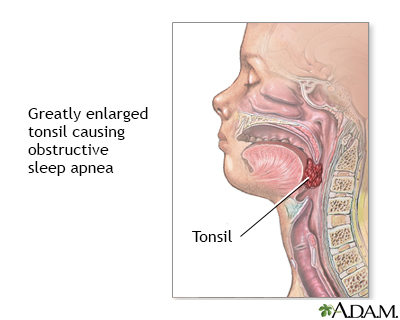Pregnancy SmartSiteTM
Sleep apnea - obstructive - adults; Apnea - obstructive sleep apnea syndrome - adults; Sleep-disordered breathing - adults; OSA - adults DefinitionObstructive sleep apnea (OSA) is a problem in which your breathing pauses during sleep. This occurs because of narrowed or blocked airways. CausesWhen you sleep, all of the muscles in your body become more relaxed. This includes the muscles that help keep your throat open so air can flow into your lungs. Normally, your throat remains open enough during sleep to let air pass by. Some people have a narrow throat. When the muscles in their upper throat relax during sleep, the tissues close in and block the airway. This stop in breathing is called apnea. Loud snoring is a telltale symptom of OSA. Snoring is caused by air squeezing through the narrowed or blocked airway. Not everyone who snores has sleep apnea though. Other factors also may increase your risk:
 Sleeping on your back can also cause your airway to become blocked or narrowed. Central sleep apnea is a different sleep disorder during which breathing also can stop. It occurs when the brain temporarily stops sending signals to the muscles that control breathing. SymptomsIf you have OSA, you usually begin snoring heavily soon after falling asleep.
Most people with OSA do not know their breathing starts and stops during the night. Usually, a sleep partner or other family members hear the loud snoring, gasping, and snorting. Snoring can be loud enough to hear through walls. Sometimes, people with OSA wake up gasping for air. People with sleep apnea may:
Other problems that may occur include:
Exams and TestsYour health care provider will take your medical history and do a physical exam.
You will need to have a sleep study to confirm OSA. This testing can be done in your home or in a sleep lab. Other tests that may be performed include:
TreatmentTreatment helps keep your airway open while you sleep so your breathing does not stop. Lifestyle changes may help relieve symptoms in people with mild sleep apnea, such as:
Continuous positive airway pressure (CPAP) devices work best to treat obstructive sleep apnea in most people.
It can take some time to get used to sleeping with CPAP therapy. Good follow-up and support from a sleep center can help you overcome any problems using CPAP. Dental devices may help some people. You wear them in your mouth while you sleep to keep your jaw forward and the airway open. Other treatments may be available, but there is less evidence that they work. It is best to talk with a provider who specializes in sleep problems before trying them. Surgery may be an option for some people. It is often a last resort if other treatments did not work and you have severe symptoms. Surgery may be used to:
Surgery may not completely cure OSA and may have long-term side effects. Outlook (Prognosis)If not treated, sleep apnea may cause:
Daytime sleepiness because of sleep apnea can increase the risk of:
In most cases, treatment completely relieves symptoms and problems from sleep apnea. Possible ComplicationsUntreated OSA may lead to or worsen heart disease, including: When to Contact a Medical ProfessionalContact your provider if:
ReferencesGreenberg H, Scharf MT, West S, Rajan P, Scharf SM. Obstructive sleep apnea: clinical features, evaluation, and principles of management. In: Kryger M, Roth T, Goldstein CA, Dement WC, eds. Principles and Practice of Sleep Medicine. 7th ed. Philadelphia, PA: Elsevier; 2022:chap 131. Kimoff RJ, Kaminska M, Pamidi S. Obstructive sleep apnea. In: Broaddus VC, Ernst JD, King TE, et al, eds. Murray and Nadel's Textbook of Respiratory Medicine. 7th ed. Philadelphia, PA: Elsevier; 2022:chap 120. Patil SP, Ayappa IA, Caples SM, Kimoff RJ, Patel SR, Harrod CG. Treatment of adult obstructive sleep apnea with positive airway pressure: an American Academy of Sleep Medicine clinical practice guideline. J Clin Sleep Med. 2019;15(2):335-343. PMID: 30736887 pubmed.ncbi.nlm.nih.gov/30736887/. Redline S. Sleep-disordered breathing and cardiac disease. In: Libby P, Bonow RO, Mann DL, Tomaselli, GF, Bhatt DL, Solomon SD. Braunwald's Heart Disease: A Textbook of Cardiovascular Medicine. 12th ed. Philadelphia, PA: Elsevier; 2022:chap 89. | |
| |
Review Date: 1/9/2023 Reviewed By: Allen J. Blaivas, DO, Division of Pulmonary, Critical Care, and Sleep Medicine, VA New Jersey Health Care System, Clinical Assistant Professor, Rutgers New Jersey Medical School, East Orange, NJ. Review provided by VeriMed Healthcare Network. Internal review and update on 02/12/2024 by David C. Dugdale, MD, Medical Director, Brenda Conaway, Editorial Director, and the A.D.A.M. Editorial team. The information provided herein should not be used during any medical emergency or for the diagnosis or treatment of any medical condition. A licensed medical professional should be consulted for diagnosis and treatment of any and all medical conditions. Links to other sites are provided for information only -- they do not constitute endorsements of those other sites. No warranty of any kind, either expressed or implied, is made as to the accuracy, reliability, timeliness, or correctness of any translations made by a third-party service of the information provided herein into any other language. © 1997- A.D.A.M., a business unit of Ebix, Inc. Any duplication or distribution of the information contained herein is strictly prohibited. | |

 Obstructive sleep ...
Obstructive sleep ...
